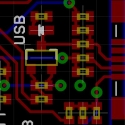Rocketgeek
Member Since: March 27, 2009
Country: United States
-
Fluke's hands are tied as well -- they had no choice but to complain. The reason is because US trademark law is structured on a use it or lose it basis. If you have a trademark, you must not only use it in commerce but also vigorously defend it.
Sparkfun might have some luck reaching out to Fluke directly -- there are ways to resolve this that don't require smashing the multimeters and protect Fluke's trademark rights.
-
The shift registers work correctly with 3.3V inputs, so the same type works with both.
-
It fits a standard 8-pin IDC ribbon connector.
-
The shift registers are 74LS595s, according to the schematic. The datasheet for these shift registers says they are capable of handling a 20 MHz clock (http://datasheet.octopart.com/SN74LS595D-Texas-Instruments-datasheet-151133.pdf).
The limiting factor is likely to be the Arduino. The shield is designed to use the hardware SPI bus, which can run up to 8 MHz. For 64 outputs, you should be able to push a new sequence out in ~8 microseconds.
However, if you just want to light up a single output in sequence over the 64. That's even faster. You push all zeros, then you push a single one. You can push that one down the stack by setting the data line low then strobing the clock and the latch lines (in that order). The new zero will push your one down the line when you strobe the clock and strobing the latch will push the new value to the outputs. You can see how this works by playing with the interactive 595 simulator at http://conductiveresistance.com/interactive-595-shift-register-simulator/
-
According to the schematic, DATPIN is now pin 11 and SCLPIN is now pin 13, in order to enable the user to write to it using the SPI hardware.
PS -- where did you find that code snippet?
-
It would be nice to have a daughtercard for the Beagle Board with nice level shifters to deal with that issue.
-
Big caveat with water-soluble flux: you MUST wash it off within 72 hours if you want your boards to last. It's far more corrosive than the rosin-based solders. And don't be fooled by water-soluble -- you have to scrub with hot DI or distilled water or drop it in a heated ultrasonic cleaner. Harbor Freight sells entirely serviceable models very, very cheap, so it's not a big deal.
-
Do you require a widget sold through you under a distributorship deal to be a SparkFun exclusive, or would someone still be able to sell it through other channels?
-
Solar thermal systems have two big advantages over photovoltaics. First, they have a significantly better EROEI (Energy Return on Energy Invested) than PV systems -- better in the best demonstrated cases than US oil production during the 1970s. Second, they don't require rare elements (such as indium) to reach best efficiency as high-efficiency PV systems do. It's all aluminum, concrete, and steel, which has major implications for future scale-up.
Put your ideology back in your pants and pay attention.
No public wish lists :(



